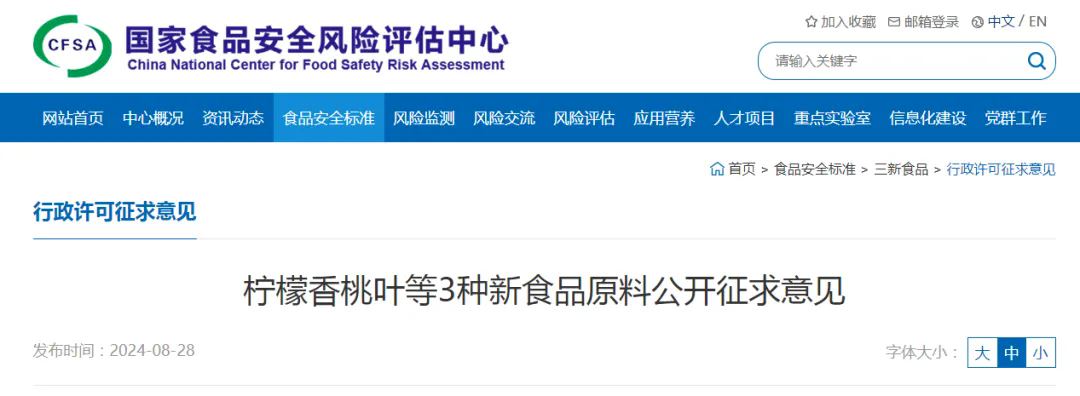
On August 28, 2024, the China National Center for Food Safety Risk Assessment (CFSA) issued a call for public comment on three new food raw materials: lemon myrtle leaf, Maqui Berry anthocyanins, and wheat polar lipids.
Comments are welcome until September 27, 2024 . The details are as follows:
1. Lemon myrtle leaf
|
Name |
Lemon myrtle leaf |
||
|
Basic information |
Source: Leaves of Backhousia citriodora F. Muell. |
||
|
Brief description of the production process |
Made from leaves of Backhousia citriodora F. Muell. through processes including harvesting, sorting, washing, and drying. |
||
|
Other information |
1. The labels and instructions shall bear a statement indicating that they should not be consumed by infants, pregnant women and breastfeeding women, along with information on the unsuitable population; 2. Food safety parameters shall comply with the following requirements: |
||
|
Lead (Pb), mg/kg |
≤ |
1.0 |
|
|
Cadmium (Cd), mg/kg |
≤ |
0.5 |
|
|
Arsenic (As), mg/kg |
≤ |
0.5 |
|
2. Maqui Berry anthocyanins
|
Name |
Maqui Berry anthocyanins |
|
Basic information |
Source: Aristotelia chilensis |
|
Brief description of the production process |
Made from the fruits of Aristotelia chilensis through processes including aqueous extraction, filtration, purification, concentration, and drying. |
|
Recommended intake |
≤ 900 mg/day (expressed as a total anthocyanin content of 35 g/100 g; for amounts exceeding this content, calculate based on the actual content) |
|
Other information |
Scope of use and maximum levels: Milk and milk products (0.8 g/kg for modified milk and flavored fermented milk, milk powder and the formulated products are converted according to the mass of liquid after preparation); beverages (0.8 g/kg for liquid beverages, solid beverages are converted according to the mass of liquid after preparation); jelly, cocoa products, chocolates and chocolate products, including chocolate and chocolate products with cocoa butter substitute (14 g/kg); candy (40 g/kg); frozen beverages (8 g/kg); bakery foods (4 g/kg); alcoholic beverages (4 g/kg); The labels and instructions shall bear a statement indicating that they should not be consumed by infants, pregnant women and breastfeeding women, along with information on the unsuitable population and consumption limits; and See the Appendix for specifications and food safety parameters. |
3. Wheat polar lipids
|
Name |
Wheat polar lipids |
|
Brief description of the production process |
Made from wheat flour through processes including ethanol extraction, acetone precipitation, separation, drying, and crushing. |
|
Recommended intake |
≤ 30 mg/day (expressed as a Digalactosyl diglyceride content of 40 g/100 g; for amounts exceeding this content, calculate based on the actual content) |
|
Other information |
Scope of use and maximum levels: Beverages (0.1 g/kg for liquid beverages, solid beverages are converted according to the mass of liquid after preparation); The labels and instructions shall bear a statement indicating that they should not be consumed by infants, pregnant women and breastfeeding women, along with information on the unsuitable population and consumption limits; and See the Appendix for specifications and food safety parameters. |
If you need any assistance or have any questions, please get in touch with us via service@hfoushi.com.
Further Information
CFSA News

